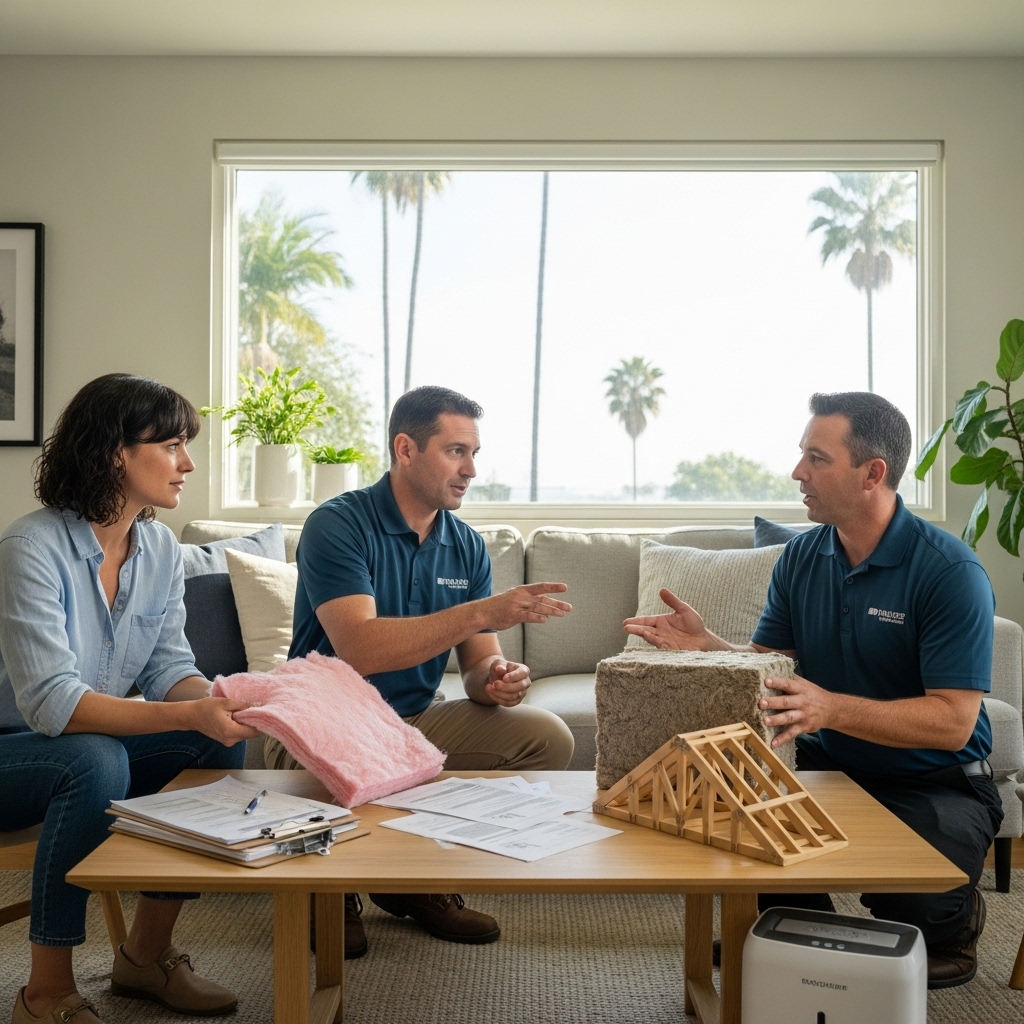Comparing attic insulation companies in Los Angeles can feel overwhelming. Different materials, methods, and promises make it hard to know who will actually deliver comfort, durability, and a clean job. The secret is to compare firms on a common framework that prioritizes building science, documentation, and customer experience over buzzwords. This guide provides a step-by-step way to evaluate companies side by side so you can choose with confidence. Early in your process, remember that true professionals treat attic insulation as part of a whole-home system rather than a stand-alone product.
When you align proposals and ask the same questions of each firm, the differences become clear. You’ll see who focuses on details that matter and who relies on generalities. The right partner will explain choices, show evidence from similar projects, and stand behind their work long after the installation is complete.
Create a Comparison Scorecard
Build a simple scorecard to compare companies on the factors that drive real results. Rate each contractor on a consistent scale and jot down notes from your conversations and site visits. Categories to include:
- Attic assessment thoroughness
- Air sealing approach
- Ventilation plan
- Material options and rationale
- Treatment of recessed lights and flues
- Ductwork evaluation
- Coverage strategy at eaves and obstructions
- Cleanliness and containment
- Documentation and verification
- Communication and scheduling
- Warranty and aftercare
By scoring each company against the same benchmarks, you convert marketing claims into comparable metrics.
What a Thorough Attic Assessment Looks Like
Expect a documented inspection with photos. The assessor should measure current coverage, identify air leaks, check soffit intake and exhaust, review duct condition, and note any hazards such as old wiring or heat sources that need special treatment. You should walk away with a clear explanation of problems, priorities, and optional enhancements tailored to your home’s layout and microclimate.
Air Sealing: Non-Negotiable for Comfort
Air sealing is a defining difference between average and excellent companies. Ask where they seal, which materials they use, and how they handle large openings like chaseways. Look for specifics: top plates, wire penetrations, plumbing stacks, the attic hatch, and transitions to knee walls. Crews should be trained to maintain clearances around heat sources and to document before-and-after conditions.
Ventilation Strategy and Eave Detailing
In Los Angeles, vent balance protects your roof and keeps insulation effective. The company should discuss soffit intake, baffles, exhaust type, and how they’ll prevent wind-washing at eaves. If your home lacks adequate intake, they should propose solutions rather than ignoring the issue.
Materials: Options, Not One-Size-Fits-All
Beware of one-material pitches. Competent companies explain the benefits and trade-offs of blown-in fiberglass, cellulose, batt systems, hybrid assemblies, and, where appropriate, roofline foam. They tailor recommendations to your attic’s geometry, access, and performance goals. The rationale should be easy to follow and backed by results from similar homes.
Fixture Treatments and Safety
Recessed lights, flues, and other heat sources require careful detailing. Ask how the company maintains required clearances, uses approved covers, and seals around housings. Safety practices should also include electrical awareness and attic navigation that avoids compressing insulation or damaging ducts.
Ducts: The Often-Missed Opportunity
Leaky or poorly insulated ducts can erase the benefits of new attic insulation. The best companies include duct inspection, sealing, support, and layout checks as part of their scope. They understand that airflow and temperature are linked and that sealed ducts amplify the value of every other step in the project.
Coverage Strategy and Quality Control
Uniform coverage is crucial. Ask how installers achieve consistent depth at eaves and around framing, prevent gaps behind obstructions, and protect low-clearance edges. Good crews use depth markers, take progress photos, and build catwalks where necessary to avoid compressing material while moving through the space.
Clean Work Practices and Containment
Attic work can stir up dust and debris. The company should outline how they protect your living areas, establish containment at the hatch, cover pathways, and use HEPA filtration during removal. Post-install cleanup should include vacuuming registers, wiping surfaces, and restoring hatch gaskets to maintain an airtight seal.
Documentation, Verification, and Transparency
Ask for before-and-after photos and a written summary of air sealing and ventilation adjustments. If feasible, request simple verification methods for key air leaks. Companies that document thoroughly tend to communicate well and deliver consistent results.
Communication, Scheduling, and Professionalism
Pay attention to how the company communicates before you hire them. Are they punctual for appointments? Do they follow up with clear notes and next steps? Do they explain discoveries during the job and invite your questions? The customer experience during planning predicts the experience you’ll have during installation.
Warranty and Aftercare
Strong companies explain their warranty plainly and designate a contact for follow-up. They also give guidance on how to protect your attic after the upgrade—what to do when adding lighting or running new wires, how to keep vents clear, and when to schedule a quick check-in after roofing or HVAC work.
Side-by-Side Proposal Comparison
Align scopes so you can compare apples to apples. Each proposal should include an air sealing plan, ventilation strategy, fixture treatments, coverage method, ductwork attention, cleanup steps, documentation, and aftercare. When proposals differ, ask why. A thoughtful, comprehensive plan for attic insulation is usually a better predictor of comfort than a minimal scope that leaves key issues unaddressed.
Red Flags to Watch
Be cautious if a company:
- Skips air sealing or calls it optional in open attics.
- Ignores soffit intake or cannot explain baffle placement.
- Offers vague one-line proposals without specifics.
- Refuses to provide photos, references, or license and insurance details.
- Downplays safety around recessed lights, flues, or wiring.
- Pushes a single material as a universal solution.
Choosing based on the lowest-effort plan often leads to uneven temperatures, moisture problems, and disappointing results.
Neighborhood and Home-Style Nuances
Los Angeles neighborhoods contain a wide range of homes: single-story bungalows with shallow eaves, hillside homes with split levels, and modern constructions with multiple attic bays. Companies with broad experience can adjust their plan for each layout—adding baffles in tight eaves, sealing behind dropped soffits in kitchens, or stabilizing temperatures in rooms under gable ends that overheat in late afternoon sun.
Frequently Asked Questions
Q: How do I verify that air sealing was actually done?
A: Request photos of each sealing location and a summary of materials used. During the walkthrough, ask the crew to point out key areas they sealed and demonstrate hatch gasket performance.
Q: Is removal necessary before new insulation?
A: It depends on contamination, moisture history, and access to hidden leaks. Clean, dry material can sometimes be augmented, but removal aids thorough sealing when the attic has been compromised.
Q: What about recessed lights and safety?
A: Companies should use approved covers or clearances, seal around housings as allowed, and follow guidelines for safe distances from heat sources and wiring.
Q: Will attic upgrades reduce noise?
A: Yes—uniform coverage, denser materials, and sealed pathways often reduce outdoor and inter-room noise.
Q: How should I compare multiple proposals?
A: Align scopes using the scorecard categories. Evaluate air sealing, ventilation, coverage strategy, cleanup, documentation, and aftercare. Focus on completeness and clarity, not just summary descriptions.
Q: What happens if hidden issues are found during the job?
A: The company should pause, document the finding, explain options, and adjust the plan with your approval. Transparent communication is part of a professional process.
Ready to Choose with Confidence
Use the scorecard, insist on complete scopes, and prioritize companies that document thoroughly and communicate clearly. When a team treats your home as a system and explains how each step supports comfort, you can expect consistent, long-lasting results. If you are ready to move from comparison to action, connect with professionals who approach attic insulation with building science, clean work practices, and reliable aftercare in mind. With the right partner, your attic will quietly support a more comfortable, healthier home.

